If you’re reading this post to learn how to write better ads then I’ve got good news for you.
You’re already on the right track.
Ad copy is the face of all your PPC efforts. It has a profound impact on your click through rate (CTR), quality score, and many other key metrics. After all, it’s the first impression people have with your brand.
Oh ya, I almost forgot. I also have some bad news — writing exceptional ad copy can be time-consuming and difficult. Especially when you’re not accustomed to all the rules and limitations.
Writing ad copy for the first time is a lot like the first time you tried to ride your bike without training wheels. It’s going to hurt a little.

Ouch!
Luckily, just like riding a bike, once you learn how to write ad copy, you’ll never forget.
This article will take you through the basics of writing Google text ads and arm you with 33 expert tips that can be applied to almost any PPC ad format.
So let’s take a few moments to get the basics down by looking at the foundation of a PPC ad.
PPC Ad Format
Each advertising platform will have it’s own unique rules and restrictions. And to make things a bit more complicated most PPC platforms also offer at least a few different ad formats.
Rather than cover each and every ad format and risk turning this article into a novel I’ll focus on Google text ads format.
Google text ads will give you a broad understanding of how PPC ads are structured and set you up for success on most other ad platforms.
The Structure of PPC Ad Copy
PPC ad copy is broken down into different parts and each part serves a specific purpose. Understanding these parts will help you apply the techniques covered later on in this article and drastically improve your ads’ performance.
Let’s get started by dissecting the Google text ad below.
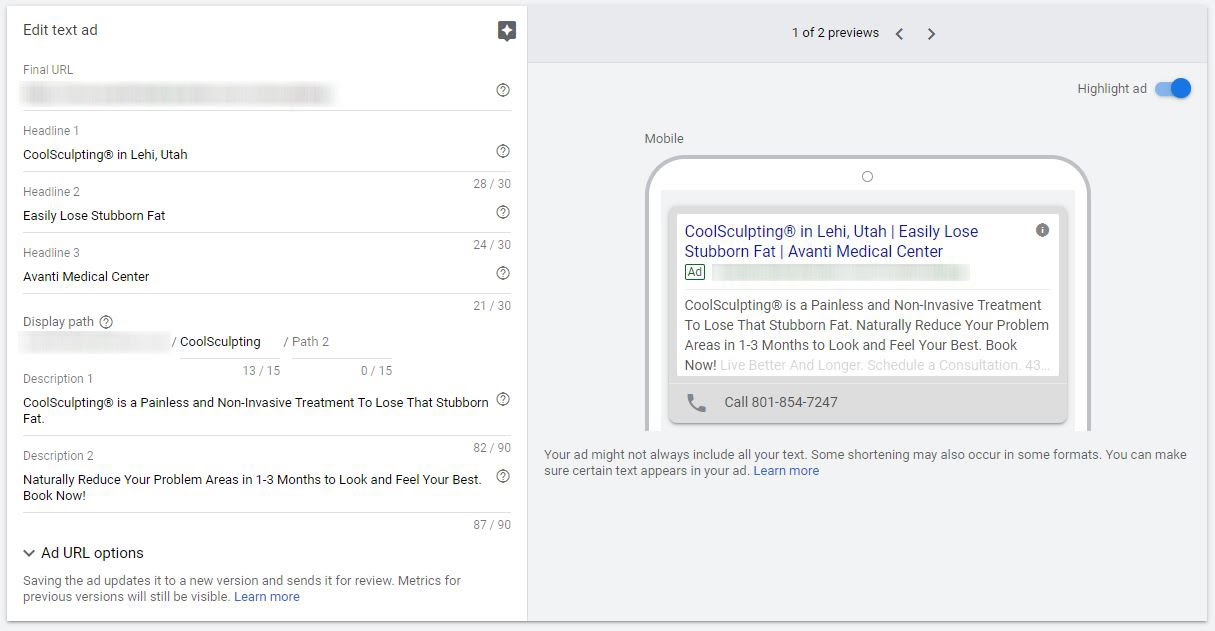
Google Ads text ad editor.
The preview pane (right) shows your ad as it could appear to a consumer and lets you switch between mobile and desktop views. Keep in mind, your ad may look different in actual search results.
So instead of worrying about the preview pane, we’re going to focus on the best ways to fill in each of the available fields.
Here’s a quick breakdown of each section:
- Final URL: This is the URL where you want visitors to go when they click on your ad. It won’t be seen by searchers so all you have to do here is enter your website or landing page URL.
- Headline 1: The main, attention-grabbing headline. It should match the user’s search term and the message on your landing page.
- Headline 2: The second headline should present your unique value proposition or offer. This could be many different things so we’ll give you a plethora of examples later in this article.
- Headline 3: The last headline is not always shown so it’s a good place for your brand or some other piece of non-essential information.
- Display Path: Not to be confused with your Final URL, the display path is for viewing purposes only. It doesn’t interfere with your URL and won’t change the landing page that users are sent to. However, it can influence a user’s decision to click your ad so make sure it contains your keywords whenever possible.
- Description 1: The description allows room for only a few sentences so you need to use the space wisely. When possible try to include your keywords and a call to action.
- Description 2: Your second description is not always shown, but that doesn’t mean you should neglect it. Use this section to answer potential customer questions and offer a secondary call to action.
Oh, I should also mention that there’s an unspoken rule of writing Google search ads. Ad headlines should always be written using title case. Title case means all words are capitalized, except non-initial articles like a, the, and, etc. I know this might seem unnatural, but it really does improve ad performance.
Pro Tip: You probably noticed the numbers next to each field. These numbers represent the number of characters that each section can contain. Do your best to max out each field’s character count whenever possible. More characters make your ad bigger and more noticeable in search results.
Ad Extensions
Ad extensions allow you to add more detailed information to your ad, including reviews, your website, phone number, company call outs ( events, products, or services.) your location, hours of operation, special promotions, and more.
There are several advantages to these extensions. Most notably, they make your ads a lot bigger and more informative which leads to higher quality traffic.
We won’t cover ad extensions too much in this article, but you don’t want to leave them out. You can learn more about ad extensions and how to use them in this in-depth article on Google Ad Extensions.
Writing PPC Ad Copy That Converts
Now that we have covered the basics of Google text ads, it’s time to dive into those ad writing tips you’ve been eagerly awaiting. These tips are designed to improve your PPC ad copy no matter what platform or ad format you use.
Whether you’re a veteran at writing ad copy or are brand new to the game, the following information will help you take your ads to the next level!
We’ve broken our ad copy tips into groups to make this article easier to navigate. Feel free to skip around using the links below.
Fundamentals
In a game of basketball, it won’t matter how many three-pointers you can sink if you can’t catch or dribble. You likely won’t score.
Like basketball, there are some fundamentals to writing PPC ad copy. So what better way to start off our list than with the fundamentals.
Tip #1: Correct Punctuation and Sentence Case
Punctuation tells readers where to pause, stop, and take notice of certain words, but perhaps, more importantly, it prevents confusion. I mean bad punctuation can really give people the wrong idea about what you’re trying to say.

See what I mean…
Now you’re probably thinking, “Okay, correct punctuation – got it. What next?”
Well, when it comes to ad copy it’s not that simple. There are a few types of punctuation you should avoid using in your ad copy.
- Exclamation mark in the ad’s headline
- Repeated punctuation or symbols
- Symbols, numbers, and letters that don’t adhere to their true meaning or purpose
- Non-standard use of superscripts
- Non-standard symbols or characters
- Bullet points
This means the most frequent punctuation in your headlines will be periods, question marks, and the occasional comma. Anything else might put your ad at risk for disapproval.
You can be a bit more liberal with your punctuation in the description text, but you should avoid writing long complex sentences. Short sentences will be more memorable, and keywords placed at the beginning or end will be even more powerful.
You’ll also want to use capitalization to your advantage. Once again, it’s not as simple as you might think.
Improper capitalization, like writing the word FREE in all caps can cause your ad to be rejected. But not everything is this black and white. See, there’s a hot debate about using all sentence case or all title case in your ad copy. The truth is, sentence case and title case both have their place in ad copy.
Sentence case is a better way to construct your ad’s description text, and title case should be used for everything else. How’s that for black and white.
Tip #2: Use The Keyword In Your Ad Path
The display path is one of those underutilized fields that has a ton of potential to improve your ads’ performance.
Here’s a screenshot to give you a better idea of where your display path shows up in search results.
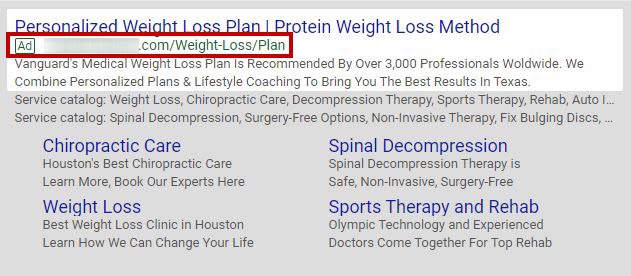
Example of a display path
In the above example, the keyword is “weight loss plan” so it’s used in the headline the description text and in the ad’s path. This makes your ad appear more relevant to viewers and Google likes it too.
Hopefully, you’re already following our recommendations and using single keyword ad groups. Otherwise, this tip might be a bit tricky to follow.
Tip #3: Every Letter Counts
According to research by CXL users spend less than 3.4 seconds viewing the first 5 search results. That’s not what I’d consider deep reading.
So if you’re going to earn some clicks then your ads need to be attention-grabbing machines. And you’ll have to accomplish all this with limited space. You’ll have to keep it short and sweet.
But we know when you’re dreaming up ad copy it’s easy to forget about character limits. So before you get carried away let’s review the allowed character counts for each field.
- Headline one: 30 characters
- Headline two: 30 characters
- Headline three: 30 characters
- Display path:15 characters in each section
- Description one: 90 characters
- Description two: 90 characters
Feeling claustrophobic yet?

How about now?
The good news is that unlike this cave there’s nothing to fear when it comes to crafting concise ad copy. In fact, it’s pretty easy when you have the right tools and tactics.
So here are ten techniques for more precise writing that are sure to calm your fears.
- Use active voice: Remove be, is, are, and other connecting words.
- Avoid vague nouns: For example, instead of writing “experts in the area of women’s fashion” write “women’s fashion experts”.
- Use words, not their definitions: Replace explanations with a single word when possible.
- Avoid noun strings: Eliminate nouns used as adjectives.
- Convert nouns to verbs: Change nouns ending in -tion to a verb
- Reduce verb phrases to simple verbs: For example, instead of writing “our pricing isn’t more expensive because of the fact that we get results” write “our pricing isn’t more expensive because we get results”.
- Use simple words: Replace long complex words with shorter more easily understood words. For example, you could write “our prices are much lower” instead of something like “our prices are substantially lower”.
- Avoid expletives: Don’t start sentences with “There is,” “There are,” or “It is.”
- Eliminate prepositional phrases: Reverse the order of nouns when the second noun is possessive. For instance, you should write “shoe purchases are half off” instead of “purchases of shoes are half off”.
- Reduce wordy phrases to single words: Cut to the chase and avoid unnecessary phrases that clutter your sentences. For example, instead of writing “due to the fact that…” just write “because…”.
Tip #4: Competitive Research
You might think you already know who your competitors are, but you could be surprised at what you find.
Since you’ll be only be competing with other businesses that are bidding on the same keywords you may or may not be competing with your arch-nemesis across the street.
So how do you find out who your mysterious online competitors are and one-up them with way better ad copy?
Luckily there’s more than one tool at your disposal.
You can start by opening a private tab or incognito window and search your keywords. You don’t need to go bananas, just search for some of your most obvious keywords, not long-tail searches or questions.
Try to answer a few questions as you search:
- What companies come up in your search first? Are they who you expected, or are there some unexpected results? Establish who your competition is.
- How are they constructing their ads? What kind of language are they using? How does it relate to the keyword(s) you searched?
- Are your competitors offering discounts? Can you beat their advertised pricing? How is your product/service quicker, more convenient, less costly?
- What is their call-to-action? Do they want more calls, web visits, or something else, and how does that relate to the purpose of your ads?
- What can you adopt in your ad copy that they’re doing or not doing to improve your click-through rate?
Using keyword research you might find competitors you didn’t know about. But more importantly, you can inform your own strategy and test out their strategies for yourself.
Besides keyword searches, you can also use the built-in ad preview tool, and spy tools like SpyFu.
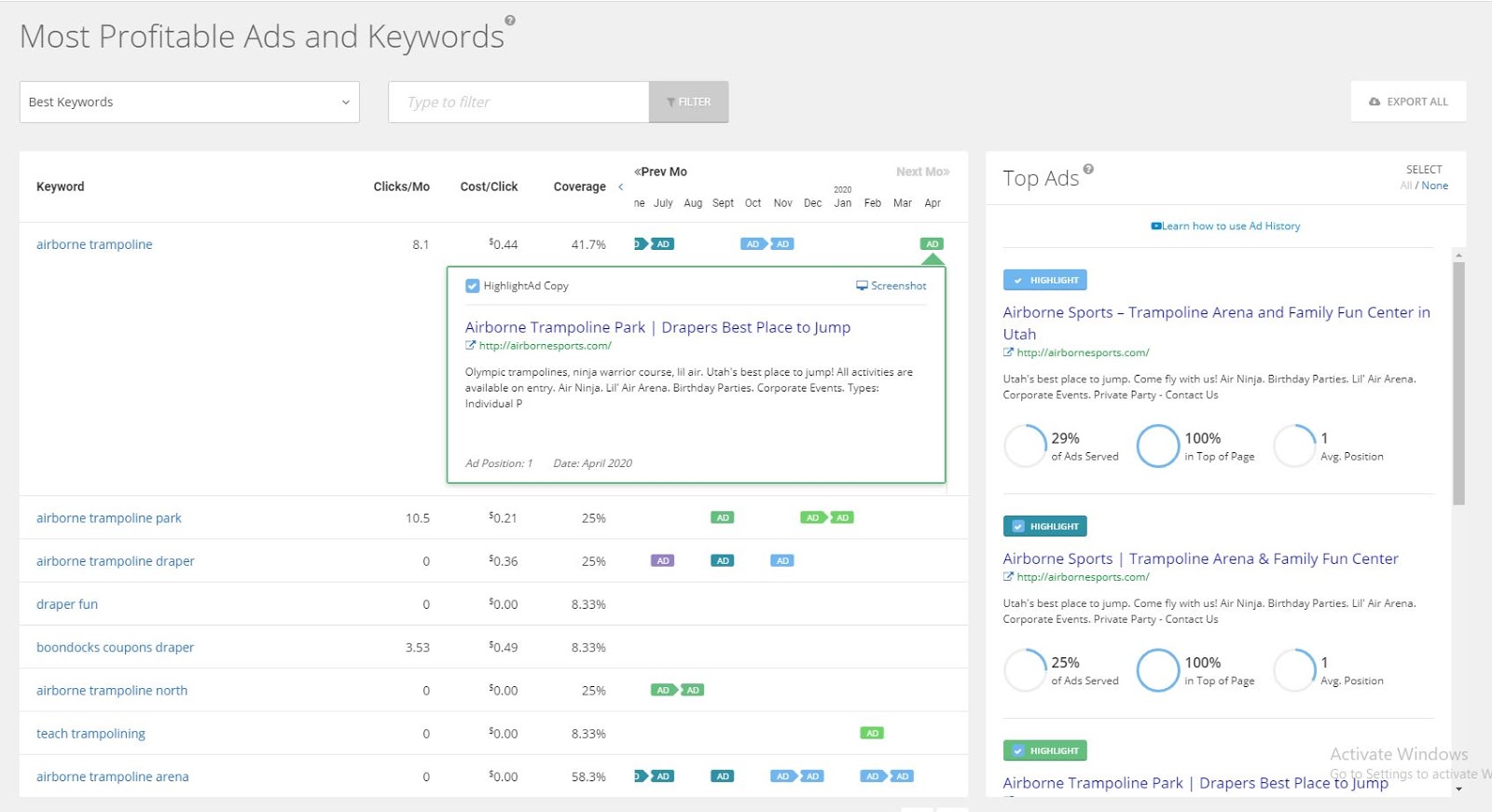
A screenshot from SpyFu
Once you have identified your competition, SpyFu can help you find their longest-running ads – an indicator that the ad performs well. After all, if you’re going to copy your competition you don’t want to copy their mistakes.
Aside from giving you some ideas to steal, competitor research can also show you what not to do. For example, if you search for dentists and see that every single ad starts with “#1 Dentist”, don’t write the same thing in your ad. People are smart, they know you can’t all be number one. Instead, be creative and unique so that your ad will stand out.
Tip #5: Be Transparent
PPC ads and landing pages work together to create conversions. This means that the content of one must match the other. If it doesn’t, the result could be worse than missing out on a conversion.
When ads and landing pages don’t match up it can result in bad reviews and damage your company’s reputation.
Take the ad below for an example. The company appears to offer custom hats, with free shipping and no minimum. The message even says the word “simple” and appears to be so.

No minimum huh?
When you click on the ad, you are taken to a page to complete your hat order. However, when you’ve filled out all of your information, you will get the following message if you leave the quantity at “1”.

A bit deceiving wouldn’t you say…
You can see the problem right away. “No minimum” actually is a minimum of three hats. Since it’s rare that someone would actually order only one hat, most people may never notice this error. However, if someone did only want one hat a fundamental flaw in the ad and the landing page is revealed: the statement “no minimum” is simply not true.
A better statement would have been “low minimum.” But now the damage is done, and the customer will likely go elsewhere. The company betrayed a fundamental principle: trust. They set up what turns out to be an unreasonable expectation, and did not deliver on what they promised.
Relevance
The tips in this section are about writing ads that are extremely relevant to your potential customers.
To get the most out of these tips, you’ll want to be using single keyword ad groups (SKAGs). SKAGs help you better match users’ search terms to the exact keyword in your account. This lets you show them the most relevant ads possible.
But this article is all about writing great ad copy. So the tips below will focus on what to write after you’ve properly structured your account.
Tip #6: Ad Extensions
I know we talked about these already, and the advantages of using them, but I couldn’t leave them out of this section.
As you can see from the ad below, using ad extensions gives you a lot more real estate in search results. They also serve another function, one we mentioned earlier and just talked in-depth about.
Ad extensions give you the opportunity to make your ads more relevant.
Some extensions don’t rely on ad copy and just present customers with preset information like your address, phone number, reviews, etc. However, sitelink extensions, callout extensions, and structured snippets give you some room to display your ad copy skills.
Take this ad by Big Lots for example:

Big Lots knows what’s up when it comes to ad extensions
Instead of slapping a few pages with boring titles into their sitelink extensions, they lead with a $300 off discount.
Too many advertisers set up boring generic ad extensions without putting much thought into them. So why not give yourself a leg up on the competition by making sure your ad extensions are top-notch.
To help you get started, here are our top 5 favorite tactics for writing ad extensions.
- Use callout extensions to specify things your business does or doesn’t offer. For example, you might not accept Medicaid, but you do accept most other insurance.
- Brag about your achievements. Whether you’ve won awards, been in business for 25 years, or have thousands of 5-star reviews – list your accomplishments.
- Get granular with your ad extensions. Set up campaign or ad group level extensions to match your ad copy even more closely with customers’ searches.
- Don’t write the same extensions as your competitors. Put your own twist on things and try to one-up them when possible.
- Don’t write your ad extensions once and forget about them. Split test the same ad with different extensions and keep trying new ideas to see which ones perform best.
Tip #7: Be Location Specific
Most PPC platforms offer extremely specific location targeting, all the way down to the zip code, and you’re likely already using these targeting features. So why not take full advantage of your location targeting by writing geographically specific ad copy.
One way to do this is to include the name of the city your targeting in the headline of your ad, but you don’t have to stop there, you can emphasizing other local aspects of your business too.
Take these ads for example:

Mentions Burbank in headline 1

Also has Burbank in headline 1
See how both ads mention Burbank
In both the ads, they use the city, Burbank, in headline 1 and again in the description text. Then they take their efforts even further with location-specific callouts and sitelink extensions.
Even though both of the ads above are from large national chains, they’ve still gone to great lengths to appear more local, and data suggests that you should too. In fact, a study by ComScore that surveyed over 5,000 consumers found that 93% of shoppers preferred local businesses.
So whether you have a small local business or run an international corporation you can benefit from writing location-specific ad copy.
Tip #8: Link From the Problem to a Solution
On their way to making a purchase customers go through three distinct stages: awareness, consideration, and decision. This is typically called the buyer’s journey, and understanding how it works can take your ad writing skills to a whole new level.
Simply put, before people search for solutions they search for problems. After they are aware of the solutions available customers compare solutions and make a decision.
Of course, you want them to decide that your solution is the best choice.
The easiest way to do this is to link from their problem to the solution you offer just like these companies have:
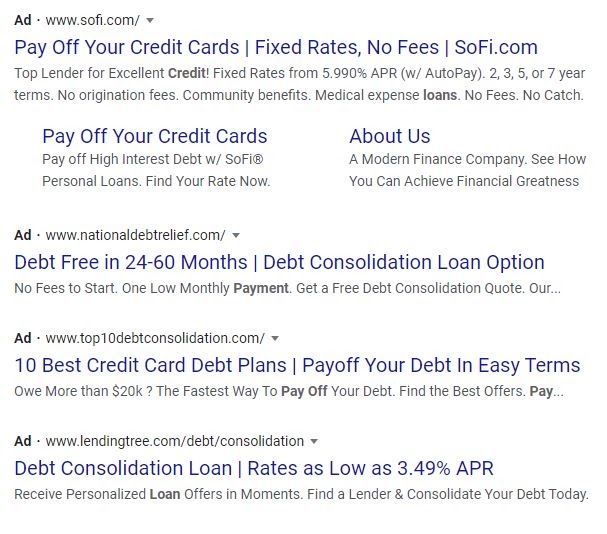
Matching problems to solutions
These companies know their customers’ problem is credit card debt and the solution is a low-interest rate consolidation loan.
I decided to include all of these ads as examples instead of only choosing one because each ad brings a different element to the table.
You can apply this tactic to your own ads by answering the following questions:
- What problem do my customers face?
- What solution do we offer that solve this problem?
- What makes your solution awesome?
Tip #9: Prevent Low-Quality Clicks
In the world of PPC, every click counts (or should I say costs), and you can’t afford to waste time and money on window shoppers.
You’ll want to use your ad copy to prequalify searchers before they even click on your ad. This way you can make sure they’re a viable customer.
The best way to accomplish this is with well-written ads that answer the following questions.
- What is your product or service? What problem does it solve?
- How much does it cost? Are discounts or financing available?
- Is your product service available in my area?
Price is especially important for high-ticket items, subscription services, and other items that require a long-term commitment or large upfront investment.
So what does this look like in action?
To give you an example let’s breakdown this ad by ScentBird.

I smell affordability right here ☝
The ad tells you the price upfront and lets you know that they offer free shipping. If you’re not looking for a subscription and don’t want to spend $14.95 a month then you probably won’t click on this ad. Goal accomplished.
Tip #10: Address Potential Customer Objections
All customers dream up reasons not to make a purchase, but the right ad copy can stop customer objections before they happen.
Take a look at this ad from Grubhub:
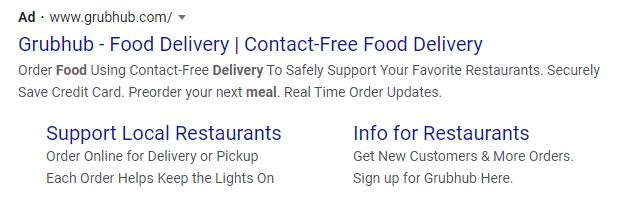
Grubhub offers contact-free food delivery.
Since many people are trying to social distance, contact with other humans is a real objection.
To overcome this objection they’ve included contact-free food delivery in the headline of their ad. This works because it relieves any safety concerns customers might have about ordering food using Grubhub.
This technique is simple, but first, you’ll need to know what objections your customers have. We recommend using customer surveys, and talking to your sales team to see what objections they face.
Tip #11 Device Specific
People’s browsing behavior varies from one device to the next and your ad copy should too.
In Google Ads, you can customize your ad copy to be better suited for mobile users by setting up an ad text customizer. This feature let’s you swap out text when your ad is viewed on a mobile device.

Google Ads IF functions
Now you can write separate ads that appeal to mobile users. Giving you yet another way to make your ads more relevant to searchers.
Tip #12: Study Organic Search Results
One of the best ways to write highly relevant ad copy starts with a little research. And in this case, you just have to scroll down (past all of the ads).
It turns out you can learn a lot about writing ad copy from organic search results.
Google tries its best to match organic search results with users’ search intent. This means that Google doesn’t only match search results based on keywords, but also the type of content that it thinks people want. Google prioritizes certain types of content when it thinks that’s what people will find most relevant.
For example, when you search for “graphic design company” all the ads are for graphic design firms looking to score business. But the top organic results are both lists of top graphic design companies. This means people who search for this are probably still pretty far up in the decision making process. They want to look at a list of several different graphic design companies before making a decision. So if you’re bidding on this term you might consider acknowledging that buyers are comparing your company to others.
When you search for “graphic design services” you’ll notice that the top results are all individual companies that offer graphic design.
So how does this knowledge help you write better ad copy?
Studying organic search results can give you a better understanding of the search intent for keywords that you’re bidding on. This way you can write ads better suited to your audience. If all the organic results for a particular keyword are list based then consider including competitive language in your ad.
For example, you could state that your the #1 on a certain list for companies in your industry. People are smart and if you’re in a competitive industry it might be hard to be all-out #1. But maybe you’re #1 on the list of fastest-growing companies in your area. Include that in your ad text and use it to your advantage.
Headlines
Since they’re oftentimes the only part of your ad that searchers read headlines pretty much make or break your ad performance. That’s why the next five tips are all about headlines.
Tip #13 Include the Keyword
This might seem like a no-brainer, but you’d be surprised by the number of ads that don’t use the exact keyword in their headline.
Take the ads below for example:
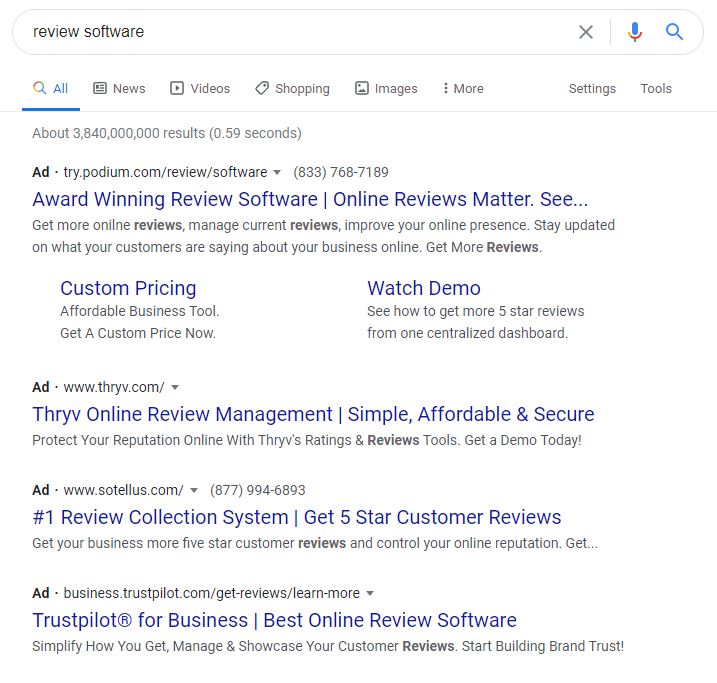
The top ad uses the search term in its headline 1
The top-ranked ad is the only one that used the exact keyword in its first headline and I’m willing to bet it’s the best performing too.
Using the keyword in your ad’s first headline lets people know that you offer exactly what they want. It also makes your ad more relevant to users and to Google Ads which means you’ll be rewarded with higher quality scores and cheaper clicks.
Tip #14: Prioritize your Keyword in the Headline
Just as important as including your keyword in the headline is where it’s placed. This is because of the way people’s minds work. When presented with a list of words, people will typically remember the first few words and the last few words, but forget those in the middle.
This data is taken from an experiment known as the Serial Position Effect, but you don’t need to read the whole study to write better ad copy. We’ve got the most important takeaways for you right here:
- The first few and last few words of your ad are the most important.
- Short sentences are more memorable than long ones.
This means that your headline, the first few words the reader sees, is the most important part of your ad. So be sure to prioritize your headline and the position of your keyword to maximize performance.
Tip #15: Using Questions in Your Headline
In real life conversations, salespeople ask questions to uncover customers’ wants and needs. This lets them present customers with appropriate solutions rather than taking the shotgun approach and seeing if something sticks.
Even though your ads can’t have conversations with searchers (yet), you can take a similar approach by using a well-crafted question in the headline of your ad.
Here’s an example:

The question in the ad relates to the keywords searched.
When using a question in the headline of your ad you may not be able to include the exact keyword, but you should make sure that the question is closely related.
For instance, a user seeing the ad above may have searched for something like, “could hormones cause a lack of motivation?”.
The ad that comes up speaks directly to the user’s problem, and in the following headline offers a solution: “restore your hormones today.”
Keep in mind, a good headline question does several things:
- It piques interest.
- It identifies the problem and the solution.
- It contains keywords to let both Google and the viewer know what the ad is about.
Tip #16: Use Exact Numbers
Numbers get everyone’s attention. You can use them to list percentages, pricing, statistics, and more. When you include numbers in your headline you check off a lot of boxes some that we’ve already mentioned.
- Numbers take up less space
- Numbers provide substance – the promise of something specific
- Numbers add structure and increase comprehension time
So ya, numbers are great, but not all numbers are created equal. Studies show that exact numbers are more believable than rounded numbers. Additionally, exact pricing like $1.99 vs $2 has been shown to increase purchases even though they’re essentially the same.
For example, check out this ad from Overnight Prints:

Check out the exact pricing 👏
It doesn’t get more specific than this and that’s what customers like. They know exactly what to expect before clicking on your ad.
Keep in mind, pricing isn’t the only way to put this tip to work. There are many other ways to use exact numbers in your headlines.
Like this ad by NICE:

Like 100% just more believable
The moral of this tip is numbers are good, exact numbers are better.
Tip #17: The Headline includes a Call to Action (CTA)
One of your headlines can, and in most cases should include your call to action. A good call to action tells customers the action you want them to take and when you want them to take it.

Expedia wants customers to reserve a car, now.
In the example above, headline two, before the name of the company, is a call to action: “Reserve Your Car Now.”
Let’s breakdown the key elements in those few short words:
Reserve: This is a command, and it tells the user exactly what you expect them to do. It is also reassuring. Knowing your car is reserved before your trip provides the traveler with a sense of security.
Your: This possessive word shows the potential customer that you are not just reserving a car or any car, you’re reserving “your” car. That sense of ownership makes it more likely the prospect will make and keep a reservation.
Car: This word is a part of the keyword and its position in the Call to Action, makes it memorable.
Now: This imparts a sense of urgency in your prospect. When should they reserve their car? Now.
The bottom line is this call to action is short and specific. It tells users exactly what to do and when to do it.
Of course, there are countless other call to action examples like:
- Buy Now
- Shop Today
- Contact Us Now
- Sign Up Today
The list goes on, but the principles remain the same.
Benefits
Why should I choose your company instead of these other companies?
This is one of the most important questions your ad copy will need to answer.
We’ve found that the best way to answer this question is with benefits-focused ad copy. Rather than trying to be the cheapest or doing what everyone else is doing, focus on what sets you apart from your competitors. Explain what makes your product, service, and company special.
Not sure where to start? Don’t worry the next five tips will help you get there.
Tip #18: Value vs. Cost
In most cases, prospects understand the difference between value and cost. For instance, you may want “cheap car insurance” before you have an accident. But once you have a negative experience with cheap auto insurance, you’ll start to consider more than just cost.
Allstate does a great job of emphasizing this with their “Mayhem” series of ads, but they are not the only company that highlights service over cost. Check out the two ads below.
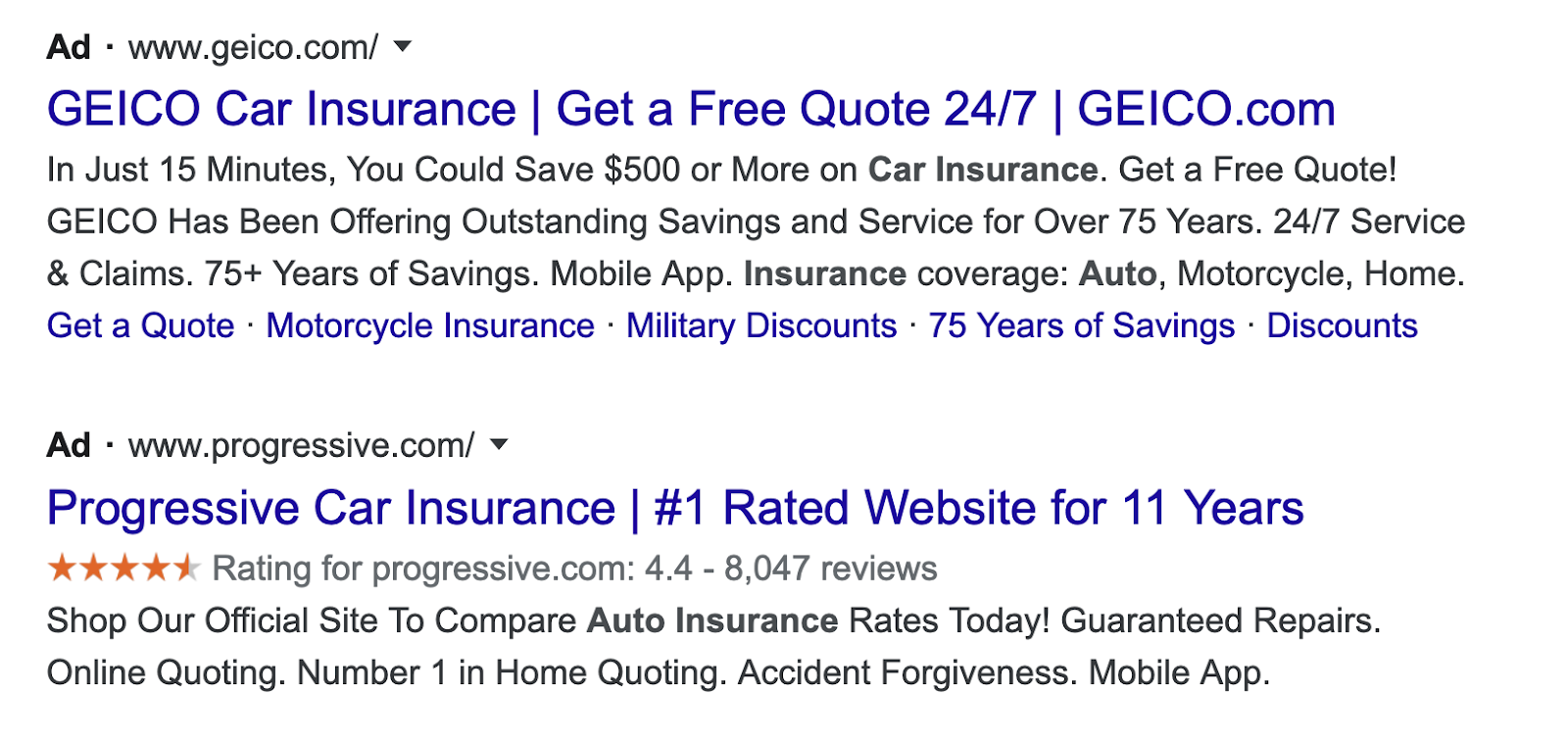
Unique features set apart similar insurance ads.
While Geico talks about free quotes and costs savings, Progressive focuses on benefits. They offer something more: the number one rated website, guaranteed repairs, accident forgiveness, and thousands of excellent customer reviews.
Highlighting value over price is especially useful when you can’t compete with competitor pricing but can offer a far superior product or service.
Tip #19: Customer Focused
John B. Peterson puts it simply in his article, Product of the Product. “Don’t sell me, show me.”
The only part of your ad that talks about you should be related to the solution you are offering the customer. The primary goal of PPC ad copy is to show the prospect that they have a problem and that your product or service is the best solution to that problem.

Home Advisor focuses on the customer.
Look at the ad above. There are several customer-focused words and phrases.
The phrase “Don’t Overpay, Compare Pros” is completely customer focused and highlights the benefits of using their service.
And they accomplish this again with “Find Background Checked Pros You Can Trust”. It states the benefit and makes a point to focus on the customer.
Keep in mind, customers don’t want to hear about you, they want to know what’s in it for them. So try to limit the use of words like we, I, us, myself, and me in your ad copy.
Tip #20: Eliminate Confusion
The goal of your PPC ad is to get the person viewing it to do one of two things: click on your ad and accept your offer or keep scrolling. You really want to keep it as simple as that. Think of the rental car ad we saw previously:

This ad offers a single choice to avoid confusion.
The choice the viewer is presented with is simple: rent your car now, or don’t. It doesn’t offer them hotels or flights or any other distractions.
First, that would be confusing. This could be a prospect who already has those things, and just wants a rental car. Second, although those are services Expedia offers, including them might give customers choice overload.
Eliminate confusion by having a clear offer and a single call to action.
Tip #21: Standing Out
When it comes to ad copy, writing the same thing as all your competitors is a big mistake in general, but especially if you have big-name competitors. Unless your ad stands out customers will pick the more well-known brand.
Take these ads for example:
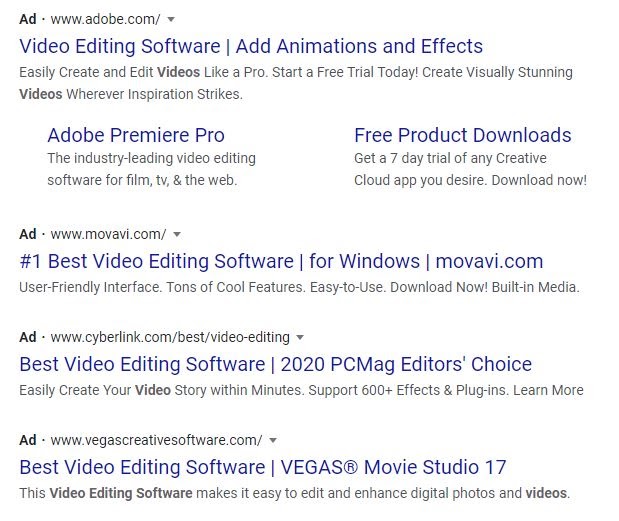
Three bests… Ya, that makes sense.
All the ads above are very similar so the only thing that stands out is Adobe since it’s a well known and highly recognized brand.
Imagine if we removed the brand names from these ads. Picking a video editing software would be like picking a door from this photo.

They’re all the same
If you want customers to pick your company then your ad copy needs to stand out.
To get started, ask yourself these questions:
- What pain points are we addressing that our competition is not?
- Can we address the same pain points, but in a better way?
- What unique value do we provide that competitors don’t?
Go back to our video editing software ads and imagine if just one of those ads had used a unique headline like: “Make a Video in 20 Minutes”. A simple benefit statement like this would have created a standout ad, different from all the rest.
In summary, focus on benefits and make prospects feel good about your product or service. Address their needs better, and in a different way, and you will stand out.
Pro Tip: Sometimes it’s okay to break the rules and test headlines without the exact keyword. If you can stand out, score a higher click through rate, and get more conversions then go ahead break all the rules.
Tip #22: Research
We mentioned competitor research, but that is not the only kind of research you should be doing. This is because your competition could be doing it wrong. You don’t want to learn martial arts from a beginner, you want to learn from the master.

See what I mean?
While competitor research is necessary, you should also consider doing other forms of research like:
- Customer Surveys
- Focus groups
- Personal Interviews (your best customers)
- Sales Team Feedback
These forms of research can unveil benefits, objections, and use cases that you never knew existed. And now you can write about them in your PPC ad copy.
Emotions
A study by a Harvard University professor found that 95% of purchasing decisions are made subconsciously and that emotions are what really drives purchasing behavior.
So it goes without saying that our next six tactics are about using emotion to write better PPC ads.
Tip #23: Keep Your Promises
One issue with PPC is ensuring that you have consistent messaging. This means everything from your ad headlines to your landing pages.
Without consistent messaging, you might end up on the wrong side of customer emotions.
For example, take a look at this ad from Billabong. It clearly promises free shipping and returns.

Billabong Ad
However, when you click on the landing page of the site, you will see a revised promise at the top of the page: you must be a part of the Billabong Crew to get free shipping, and when you dig deeper on the page, you will notice that if you are not a member, you will pay a charge for each return.

Billabong support page…
The issue here is that your PPC ad copy, while it might convert in this case, makes a promise the company does not keep. This immediate disconnect will likely turn shoppers off, and create an atmosphere of distrust. Once that trust is broken, it will be nearly impossible for the brand to earn it back.
The emotional response you want users to have to your ad is one of trust and safety. Be sure your ad copy communicates that.
Tip #24: Credibility
Credibility can be communicated in a variety of ways from company awards and statistics to customer reviews and years in business. And in case you’re wondering, no, there’s no such thing as too much credibility.
Check out this ad by Smart Sheet, for example.

That’s a lot of users
Products and services that are used by a lot of people are seen as instantly more credible. This is because of a psychological phenomenon that is often referred to as social proof.
Don’t worry, you don’t need three million customers to make your ads credible.

I haven’t even been alive this long
This accident attorney uses a zero fee guarantee and the 35+ years they’ve been in business to add to their credibility.
Or take a page from this ad by L.L.Bean:
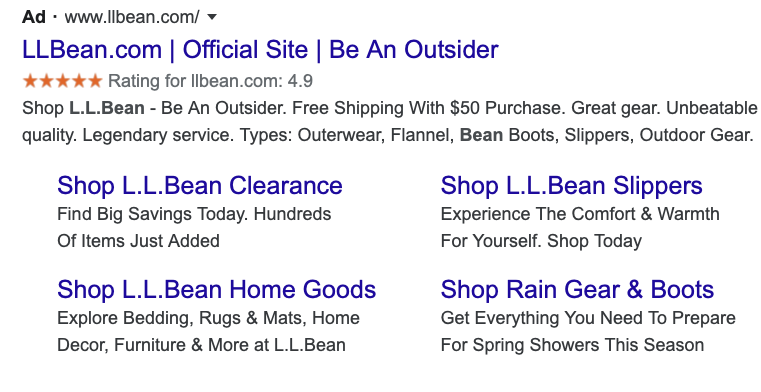
L. L. Bean offers social proof with a 4.9-star rating.
The takeaway is, whatever credibility your brand has, be sure to incorporate it in your PPC ad copy.
Tip #25: Using Ego
As we said earlier, your customers are all about themselves. In fact, the theory of psychological egoism states that everything people do is motivated by self-interest.
Don’t worry we’d never accuse you of being selfish. These are your customers we’re talking about.
The good news is you can use this theory to your advantage and appeal to your customer’s ego. This means using phrases like “you work hard”, “you deserve the best”, or “you have a great website”.
Essentially you are telling the customer that because of who they are, they deserve your product or services. If you can make them feel good about themselves you’ll be rewarded with more clicks and conversions. And before you know it you’ll be patting yourself on the back for a job well done.

Even better than patting yourself on the back
Tip #26: Use Pain or Fear
The primary function of pain or fear in ad copy is to show the prospect the consequences of not responding to your ad.
This is useful for products like insurance, pest control, security services or equipment, and others. For example, this ad for earthquake insurance offers protection for your home or business.

Afraid of earthquakes? This ad offers protection.
They don’t come right out and telling you to be afraid of earthquakes – because that would be weird. Instead they use phrases like “protect your home” and “save your assets”. These phrases trigger the fear of earthquakes and offer a solution at the same time.
You can also use pain to trigger customer emotions as this ad does.

No one wants to be in pain
This ad for spinal decompression assures customers that it will relieve their pain and offers additional health benefits too.
Remember, you don’t always need to use the words fear or pain. You can emphasize specific thoughts, feelings, and benefits to indirectly trigger these emotions.
Tip #27: FOMO
Another type of fear you can use to your advantage is the fear of missing out (FOMO). You can do this by implying limitations like:
- Limited-time discounts, promotions, etc
- Limited-quantity products, tickets, seats, etc.
- Exclusive offers (i.e. only available to current customers, subscribers, etc.)
These types of limitations make customers fear they will miss out on either savings or a special offer unless they take action right away.
One way to take advantage of this is including a call to action attached to a number. For example, you could write “Free to the First 100 Customers”.

Fear of missing out drives sales.
This type of FOMO is what fuels things like Black Friday and Cyber Monday. Things like “countdown deals” and “limited time offers” all fall into this category.
Below is an example of an “End of Season Sale” that inspires FOMO. While there is no date limit, the “season” implies a limited time offer.

A limited time offer spurs conversion.
Clearance sales and other similar limited quantity or time-sensitive offers also trigger the same response. Using FOMO in your ad copy is a sure way to increase conversion rates.
Bonus Tip: You can add countdown timers to your Google Ads alongside your discounts and offers to make the fear of missing out even stronger. You can even use scripts to update countdowns in multiple ad groups at the same time.
Tip #28: Catchphrases and Acronyms
You can help your ads catch more attention by using memorable catchphrases, slogans, or well-known acronyms.
Take this ad by Zales for example:
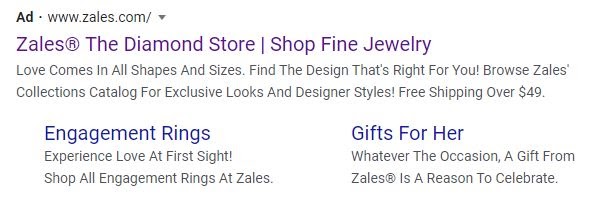
The Diamond Store
They have a well-developed brand and many people shopping for jewelry will recognize their slogan. However, even smaller less developed brands can start building recognition with a well-crafted catchphrase.
Remember good catchphrases and slogans are relevant, memorable, and usually invoke some sort of emotional response.
Another way to grab attention is to use an already well-known acronym like Alo Yoga does.
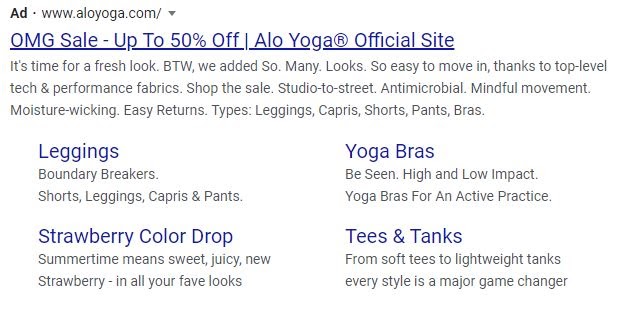
OMG Sale instantly earns a smile
Repetition
Writing a few ads and calling it quits isn’t going to get you the results you want. That would be like doing one bicep curl and expecting to look like Arnold Schwarzenegger.

No chance!
If you want to perfect your ad copy and maximize your results you’ll have to repeatedly work at it.
Lucky for you, we’ve created these next five tips to show you how.
Tip #29: Testing
If you’re following Google’s recommendations then you’ll have at least three ads per ad group, but that’s not always necessary. Depending on how much traffic you have you may only have enough data to test two ads.
Either way, you should always have a test running. Ad testing lets you determine the winning ad based on data and not just assumptions. Consistent data-driven tests will improve your ad copy and account performance.
Generally you want to let ad tests hit a 90% confidence level before pausing the losing ad and starting a new test.
Here are two ads fighting it out to see which headline performs best.

Testing Headline 1
Begin your ad copy tests with headline text since it will have the biggest impact on ad performance. You can test small changes like swapping out a single word or try changing out all three headlines with something entirely different. When you find something that works don’t stop there. Keep making changes to your description text, display path, and ad extensions to see if you can give your ad an additional boost.
Bonus Tip: You can use google ad scripts to automate your split testing and automatically label the winning and losing ads.
Tip #30: Illusory Truth Effect
We all have the tendency to believe something is true after being exposed to it repeatedly. This is commonly referred to as the illusory truth effect.
“When a “fact” tastes good and is repeated enough, we tend to believe it, no matter how false it may be.” – fs.blog
For example, the phrase “You can save up to 15% on car insurance,” immediately makes most people think of a talking Gecko and Geico. Even though we know it’s just a fictional marketing campaign the Geico Gecko seems very real. More importantly it’s memorable.
You can accomplish this with your own ads by picking a message and sticking to it. If you include it across all your PPC ad copy and engrain it into your brand eventually your customers will believe it.
Tip #31: RLSA
Sometimes seeing your ad once just isn’t good enough for customers to purchase.
Try not to take it personally though. A recent study by ReadyCloud showed that consumers were 70% more likely to convert when retargeted.
We hear a lot about remarketing to visitors who have already visited your site, but who left for one reason or another. It could have been that they were just shopping around and not yet ready to buy, or they might have seen a better deal elsewhere. Either way, Remarketing List for Search Ads (RLSA) gives you a second chance to close the deal.
See the below ad for an example of what a standard ad would look like compared to an RLSA ad.
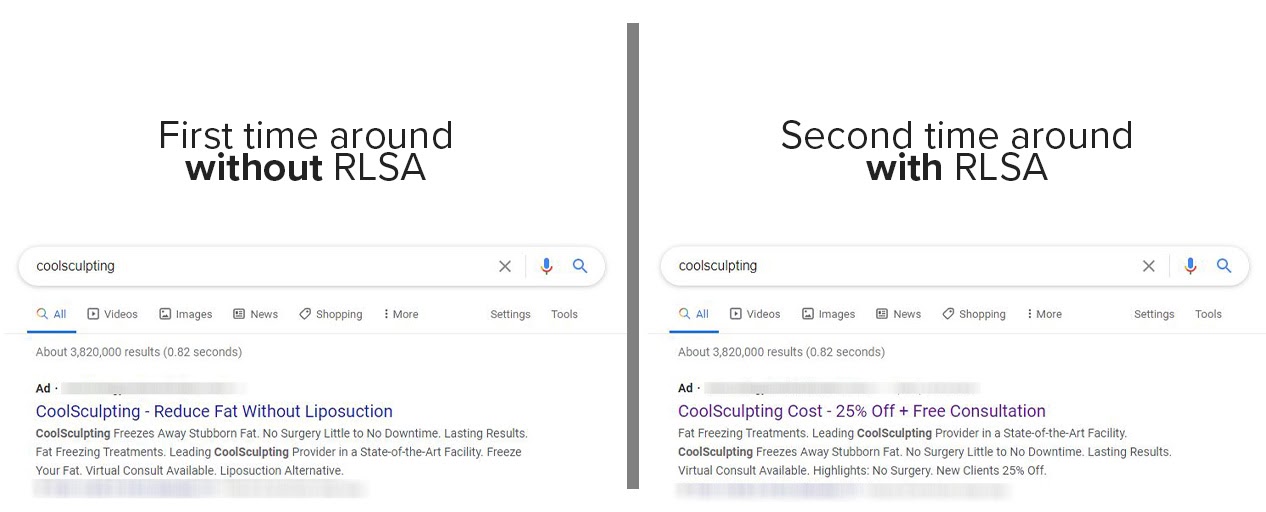
Remarketing is a second chance at a conversion.
Notice that the RLSA ad offers a 25% discount and a free consultation, unlike the original.
RLSA gives you the opportunity to write ads specifically tailored to past visitors. Since these searchers are already familiar with your brand you’ll have a better chance at converting them especially with a customized offer.
Here are a few techniques to try when writing RLSA ads:
- Offer a bigger/better discount than your competitors
- Use a limited time offer
- Add a special or unique offer
Tip #32: Cohesive Messaging
You can magnify your ad copy’s effectiveness by using similar ad messaging on multiple PPC platforms. Even though this article is more specifically about writing Google text ads many of the tactics listed can be used on Facebook Ads, Instagram Ads, Microsoft Ads, and many other PPC channels.
When you create cohesive messaging with your PPC ad copy users are more likely to take action on your offer. Plus you’re able to target all the different stages of the buying cycle more effectively.
Multipurpose your ad copy and you’ll also save yourself some time.
Tip #33: Engagement
A customer will often see your ads several times before they are moved to the point where they take action. Remember, they are moving through the marketing funnel, and the sooner you can bring them to conversion, the sooner the ad pays for itself.
This is why your ad copy must be designed to reach customers at all the various stages in the funnel and engage them to move to the next one. This incorporates many of the elements we’ve already discussed.
To make sure your ad copy is engaging throughout the entire buyer’s journey we created this graphic.
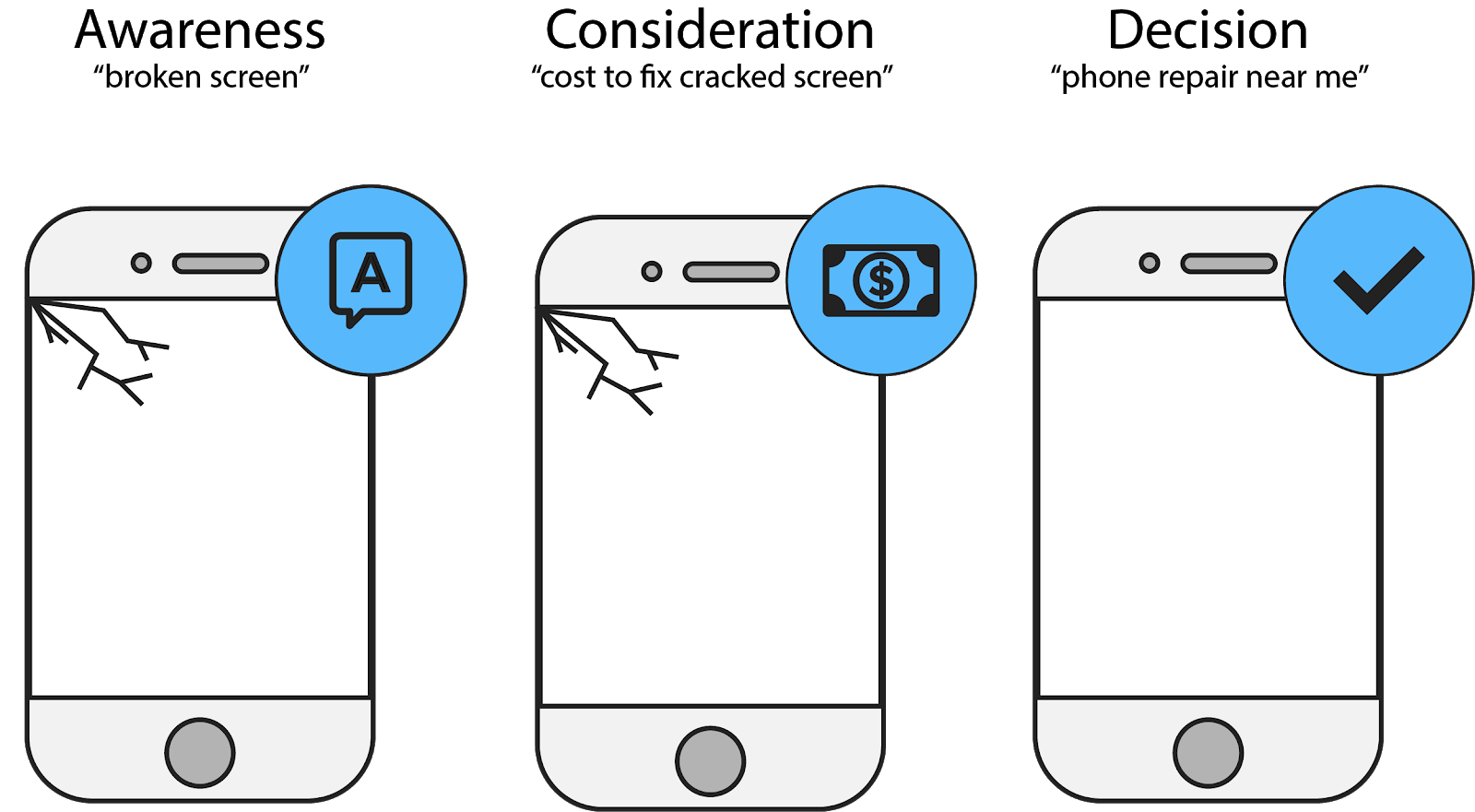
Different searches make up the buyers journey
You can use your ad copy to answer the buyer’s questions at different stages. Remember it can take several steps to earn a conversion, but if you match your ad copy to each point of the customer journey you’ll get more conversions.
Conclusion
In case you didn’t notice this article offers a lot of different solutions to writing ad copy. That’s because there’s no one tactic that works every single time. The formula that works the best will be different for every company and industry. The best way to maximize conversions is to test all different strategies and techniques to find out what works best for your business.
So I guess you could say that writing great ad copy is both an art and a science.
Let us know what techniques work best for you in the comments below, or if you want us to write your ads for you, grab a free proposal.
Luke Heinecke
Founder/CEO
Luke is in love with all things digital marketing. He’s obsessed with PPC, landing page design, and conversion rate optimization. Luke claims he “doesn’t even lift,” but he looks more like a professional bodybuilder than a PPC nerd. He says all he needs is a pair of glasses to fix that. We’ll let you be the judge.
Leave us a comment.
Subscribe to our blog
Subscribe to our blog
Get weekly PPC & CRO advice sent straight to your inbox.